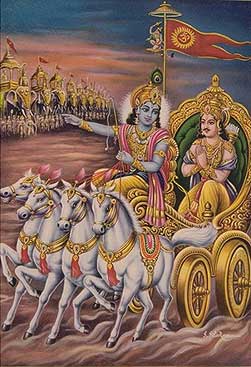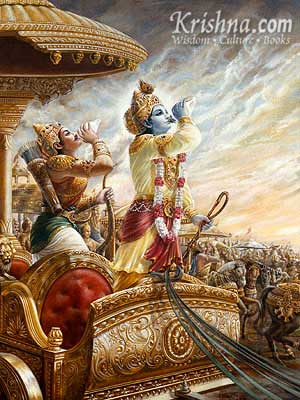For thousands of years, we have believed in the divinity of Shri Krishna. For us he was a Karmayogi par excellence who gave us action oriented philosophy of life in the form of Bhagavad Gita. But questions have constantly haunted us as to whether Krishna was a historical or mythical character and whether the war of Mahabharata was actually fought.

The advent of Geeta
Till recently, we did not have the
wherewithal to search for and establish the truth. But modern scientific tools
and techniques like computers with planetarium softwares, advancements in archaeological
and marine archaeological techniques, earth-sensing satellite photography and
thermo-luminescence dating methods, all have made it
possible to establish
the authenticity and dating of many events narrated in ancient texts like the
Mahabharata. Recent archaeo- astronomical studies, results of marine-archaeological
explorations and overwhelming archaeological evidence have established the historicity
and dating of many events narrated in the Mahabharata. These have led
to the
conclusion that Mahabharata War was actually fought in 1478 BC and Shri Krishna's
Dwarka City got submerged under the sea in 1443 BC.

The Mahabharta - :Lord Krishna and Arjuna blow their conches
Astronomical
Evidence: In the Mahabharata references to sequential solar and lunar eclipses
as also references to some celestial observations have been made. Dr RN Iyengar,
the great scientist of Indian Institute of Science, Bangalore, examined relevant
references and searched for the compatible dates by making use of planetarium
software (PVIS and EZC). He concluded that most of these references were internally
consistent and that the eclipses and celestial observations of Mahabharata belong
to the period 1493 BC-1443 BC of Indian History, (refer Indian Journal of History
of
Science/38.2/2003/77-115).
In the Mahabharata, there are references
to three sequential solar eclipses and some other planetary positions. Reference
to the first solar eclipse comes in the Sabha Parva (79.29), graphically described
by Vidur when Pandavas start their journey to the forest on being
banished
for 12 years of life in exile and one year of life incognito after they had lost
everything in the game of dice. After 13 years of exile and incognito life, the
Pandavas returned to Hastinapur and demanded their kingdom back, but Duryodhana
refused. Several efforts to prevent war failed and war became imminent.
There
is a reference to the second solar eclipse in the Bhisma Parva (3.29), following
a lunar eclipse occurring within the same fortnight a few days before the actual
war of Mahabharata. These eclipses occurred after 14-15 years of the first solar
eclipse The epic also refers to some unfavorable planetary positions between the
second solar eclipse
and the beginning of the war on Kartika Purnima (Bhisma
Parva 3.14 to 3.19). On Kartika Krishna Ashtami, Saturn was near Rohini and Mars
was between Jayestha and Anuradha. Twenty two days later, on Kartika Purnima,
Saturn was near Rohini, Mars was near Jayestha (probably Uranus) was between Citra
and Swati.
Another white planet (possibly Jupiter) had moved from Purva-bhadra
toUttar-bhadra. Reference to the third solar eclipse comes in the Mausala Parva
(2.19 to 2.20) occurring in the 36th year of the Mahabharata War.
This was
visible from the city of Dwarka, which is stated to have been subsequently submerged
under the sea. For these observations to be internally consistent, there should
have been three solar eclipses within 50 years. The first one and the second one
after a gap of 14-15 years should have been visible from Kurukshetra whereas the
third solar
eclipse should have been visible from Dwarka after 35 years of
the second one.
Marine Archaeological explorations around Dwarka: The on-shore
and off-shore explorations carried out in and around Dwarka during last 50 years
have revealed that Dwarka was a prosperous city in ancient times, which was destroyed
and reconstructed several times. The work of great excavators like ZD Ansari and
MS Mate and chance discovery of temples of 9th century AD and 1st century AD buried
near the present
Dwarkadhish Temple, prompted setting up of a Marine Archaeology
Centre jointly by the National Institute of Oceanography and the Archaeological
Survey of India. A project for marine archaeological explorations in Dwarka was
initiated under the dynamic leadership of great marine archaeologist Dr Rao, who
has the distinction of being awarded "The World Ship Trust Award" for
outstanding research in this field.
Dr Rao's team consisted of expert under-water
explorers, trained diver-photographers and archaeologists. The technique of geophysical
survey was combined with the use of echo-sounders, mud-penetrators, sub-bottom
profilers and under-water metal detectors. This team carried out 12 marine archaeological
expeditions between the year 1983 to 1992 AD and articles/antiquities recovered
were sent to Physical Research Laboratory for dating. By using thermo- luminescence,
carbon dating and other modern scientific techniques, artifacts were found to
be belonging to the period 15th to 18th century BC. In his great work, The Lost
City of Dwarka, Dr Rao has given scientific details of these
discoveries and
artifacts.
Conclusions arrived at after carrying out these under-water archaeological
explorations support and validate the dates arrived at through astronomical calculations.
These also prove that the reconstructed city of Dwarka was a prosperous port town,
and that it
was in existence for about 60-70 years in the 15th century BC
before being submerged under the sea in the year 1443 BC.
Attempts have
also been made to determine the year of Mahabharata from the details available
in scriptures which include Puranas. When events are unrecorded for quite some
time and are passed on to the succeeding generations through Shruti and Smriti,
the inaccuracies and myths get mixed with reality on account of differences in
the perceptions of different individuals. However, it is for the objective rational
individual mind to find out and differentiate fact from fiction. Important information,
including the genealogy charts of rulers after Yudhishthira, are available in
Srimad Bhagvatam, Matsya Puran and Vayu
Purana. On the basis of such evidence,
famous historian Lord Cunningham assigned the year 1424 BC to the War of Mahabharata.
Evidences
referred to earlier point more to the probability that nobody had come to India
from Central Asia or from any other place. In fact, Indo-Aryan kings and warriors
had come to Kurukshetra in their war chariots from all over India to participate
in the Mahabharata War and that a whole lot of people got killed in that war.
The killers as well
as the killed, the victors as well as the vanquished,
the charioteers as well as the foot soldiers, all were Indians who had already
experienced thousands of years of prosperous and advanced civilization. Archaeology
also records a continuous indigenous evolution of Vedic civilization going back
to 5000 BC at sites like Mehrgarh and Koldi.
It is sad that so far we have
not known even a fraction about our ancient civilization and cultural achievements.
Detailed factual data in our ancient texts and Sanskrit manuscripts is beckoning
us to carry out further research. By making use of modern scientific instruments
and techniques we must discover the true facts about our ancient past. If
we do, we may be able to gather supportive evidences to reassert that ours was
the oldest civilization in the world and that our ancestors, the Vedic Aryans,
had travelled from India to various parts of Asia and Europe to spread our knowledge,
civilization and culture. When this is recorded we would be able to hold our heads
higher and be able to take on the future with greater confidence.
-----------
courtesy
of Hinduism
Today
